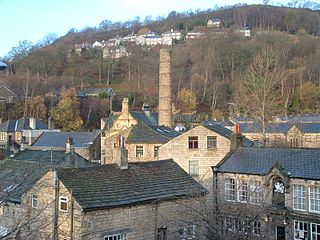Related Research Articles

West Yorkshire is a metropolitan and ceremonial county in the Yorkshire and the Humber region of England. It is an inland and upland county having eastward-draining valleys while taking in the moors of the Pennines. West Yorkshire came into existence as a metropolitan county in 1974 after the reorganisation of the Local Government Act 1972 which saw it formed from a large part of the West Riding of Yorkshire. The county had a population of 2.3 million in the 2011 census making it the fourth-largest by population in England. The largest towns are Huddersfield, Castleford, Batley, Bingley, Pontefract, Halifax, Brighouse, Keighley, Pudsey, Morley and Dewsbury. The three cities of West Yorkshire are Bradford, Leeds and Wakefield.

Kirklees is a local government district of West Yorkshire, England, governed by Kirklees Council with the status of a metropolitan borough. The largest town and administrative centre of Kirklees is Huddersfield, and the district also includes Batley, Birstall, Cleckheaton, Denby Dale, Dewsbury, Heckmondwike, Holmfirth, Kirkburton, Marsden, Meltham, Mirfield and Slaithwaite. Kirklees had a population of 422,500 in 2011; it is also the third largest metropolitan district in England by area size, behind Doncaster and Leeds.

The Calder Valley line is a railway route in Northern England between the cities of Leeds and Manchester as well as the seaside resort of Blackpool. It is the slower of the two main rail routes between Leeds and Manchester, and the northernmost of the three main trans-Pennine routes.
The Wakefield line is a railway line and service in the West Yorkshire Metro and South Yorkshire Passenger Transport Executive areas of northern England. The Wakefield line is coloured yellow on maps and publications by West Yorkshire Metro. The line was electrified in 1989, between Leeds & Wakefield Westgate, as part of the programme to electrify the East Coast Main Line.

A civil parish is a subnational entity, forming the lowest unit of local government in England. There are 101 civil parishes in the ceremonial county of West Yorkshire, most of the county being unparished. At the 2001 census, there were 557,369 people living in the parishes, accounting for 26.8 per cent of the county's population.

Metro is the passenger information brand used by the West Yorkshire Combined Authority in England. It was formed on 1 April 1974 as the West Yorkshire Passenger Transport Executive (WYPTE) at the same time as the metropolitan county of West Yorkshire. The Metro brand has been used from the outset, and since the formal abolition of the WYPTE on 1 April 2014, it has been the public facing name of the organisation. The transport authority of West Yorkshire, responsible for setting transport policy, is the West Yorkshire Combined Authority. The WYCA is also responsible for delivery of transport policies.

Normanton was a county constituency represented in the House of Commons of the Parliament of the United Kingdom. It elected one Member of Parliament (MP) by the first past the post system of election.

Hebden Royd is a town and civil parish in the Metropolitan Borough of Calderdale in West Yorkshire, England. According to the 2001 census it had a population of 9,092, rising to 9,558 at the 2011 census. It includes Hebden Bridge, Mytholmroyd and Cragg Vale. The parish was an urban district before 1974, created in 1937 by the merger of Hebden Bridge and Mytholmroyd urban districts.

Milnsbridge is a district of Huddersfield, West Yorkshire, England, situated 2 miles (3 km) west of the town centre, and in the Colne Valley. The name is said to have derived from the water-powered mill and the bridge that stood alongside it in the 13th century.
There are over 3,300 listed buildings in City of Leeds district. Lists of buildings in the upper two categories can be found at Grade I listed buildings in West Yorkshire and Grade II* listed buildings in Leeds.

The West Yorkshire Fire and Rescue Service (WYFRS) is the county-wide, statutory emergency fire and rescue service for the metropolitan county of West Yorkshire, England. It is administered by a joint authority of 22 people who are appointed annually from the five metropolitan boroughs of West Yorkshire, known as the Fire and Rescue Authority.

First West Yorkshire operates both local and regional bus services in West Yorkshire, England. It is a subsidiary of the FirstGroup, and is made up of three sub-division brands: First Bradford, First Halifax, Calder Valley & Huddersfield and First Leeds.

Scouting in Yorkshire and the Humber is largely represented by the Scout Association of the United Kingdom and some Groups of traditional Scouting including the Baden-Powell Scouts' Association.

The West Riding County Football Association is the governing body of football in northern parts of the West Riding of Yorkshire, England. Its headquarters are in the village of Woodlesford, 6 miles (9.7 km) south east of Leeds.

This is an as yet incomplete list of listed buildings in England, which are the majority of the listed buildings of the United Kingdom.
The Yorkshire Rugby Football Union is the governing body responsible for rugby union in the historic county of Yorkshire, England. It is one of the constituent bodies of the national Rugby Football Union having formed in 1869, the union was formerly called Yorkshire County Club.
References
- ↑ "Listed Buildings". Historic England . Retrieved 15 April 2019.